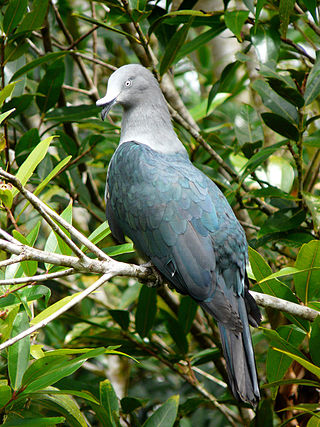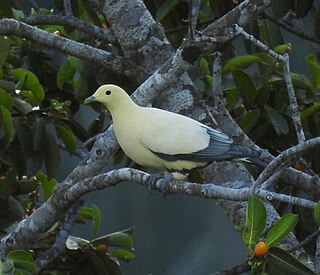
Columbidae is a bird family consisting of doves and pigeons. It is the only family in the order Columbiformes. These are stout-bodied birds with short necks and short slender bills that in some species feature fleshy ceres. They primarily feed on plants, and can be taxonomically divided amongst granivores, that feed mostly on the ground on seeds, and frugivores, that feed mostly on fruits, from branches. The family occurs worldwide, often in close proximity with humans, but the greatest variety is in the Indomalayan and Australasian realms.

The pied imperial pigeon is a relatively large, pied species of pigeon. It is found in forest, woodland, mangrove, plantations and scrub in Southeast Asia, ranging from Myanmar and Thailand, throughout Indonesia and east to the Philippines and the Bird's Head Peninsula in New Guinea. It is mainly found on small islands and in coastal regions. It remains locally common, and is therefore considered to be of least concern by BirdLife International and IUCN.

The Nuku Hiva imperial pigeon, also known as the Marquesan imperial pigeon or Upe, is a pigeon which is endemic to Nuku Hiva in the Marquesas Islands of French Polynesia. This pigeon is only found in some valleys in the western part of that island.

The blue pigeons are a genus, Alectroenas, of birds in the dove and pigeon family Columbidae. They are native to islands in the western Indian Ocean.

The Polynesian imperial pigeon or Society Islands pigeon is a species of bird in the family Columbidae. It is endemic to French Polynesia. Its natural habitat is subtropical or tropical moist lowland forest and subtropical or tropical moist montane forest. It is threatened by habitat loss.

Ducula is a genus of the pigeon family Columbidae, collectively known as imperial pigeons. They are large to very large pigeons with a heavy build and medium to long tails. They are arboreal, feed mainly on fruit and are closely related to the other genus of fruit-eating doves, Ptilinopus. Both genera display brightly coloured plumage, predominantly green, often with contrasting under-parts of purple, orange or red. Some Ducula have prominently swollen ceres. They have large gapes and swallow seeds whole, playing an important role in seed dispersal.

The cinnamon-bellied imperial pigeon or cinnamon imperial pigeon is a species of bird in the family Columbidae. It is endemic to the northern Moluccas. Its natural habitat is subtropical or tropical moist lowland forests.
The spotted imperial pigeon, also known as the grey-necked imperial pigeon, is a species of bird in the family Columbidae. Endemic to the Philippines, it lives in forests and forest edges but goes down to the limestone shorelines possibly to feed. It is a vulnerable species threatened by habitat loss and hunting.

The barking imperial pigeon, also known as Peale's imperial pigeon, is a species of bird in the pigeon family Columbidae. It is endemic to Fiji, where it occurs on most of the medium and large islands.

The silver-tipped imperial pigeon, also known as the white imperial pigeon or white-tipped imperial pigeon, is a relatively large species of bird in the family Columbidae. It is endemic to forest, woodland and mangrove on Sulawesi and smaller nearby islands.

The black imperial pigeon, also known as the Bismarck imperial pigeon, is a species of bird in the pigeon family, Columbidae. First described by English zoologist Philip Sclater in 1878, it is endemic to the Bismarck Archipelago, where it mainly inhabits rainforest and cloud forest in mountain areas above 500 m (1,600 ft). It is a large, heavily built imperial pigeon, with a length of 38–43 cm (15–17 in) and a weight of 661–665 g (23.3–23.5 oz). Adults are almost entirely black, except for the dark chestnut undertail coverts, the silvery-grey underside of the tail, and a pale grey scaly pattern on the wings and back. Both sexes look alike. Juveniles differ from adults in having paler undertail coverts.

The Micronesian imperial pigeon, also known as the Micronesian pigeon, and Belochel is a species of bird in the family Columbidae (doves). It is found in Palau, the Caroline Islands, the Marshall Islands and Nauru. Its habitats include montane forests, secondary forests, forests on beaches, and mangroves. It is threatened by hunting and deforestation, and the IUCN has assessed it as a near-threatened species.

The spectacled imperial pigeon is a species of bird in the family Columbidae. It is endemic to the Maluku Islands.

Pinon's imperial pigeon or Pinon imperial pigeon is a species of bird in the family Columbidae. It is found in New Guinea. The species is named after Rose de Freycinet née Pinon. Several subspecies have been designated:
The grey-headed imperial pigeon is a species of bird in the family Columbidae. It is endemic to Sulawesi in Indonesia. Its natural habitats are subtropical or tropical moist lowland forests and subtropical or tropical moist montane forests.

The red-knobbed imperial pigeon is a bird species in the family Columbidae. It is found in Bismarck Archipelago and the Solomon Islands archipelago. Its natural habitat is subtropical or tropical moist lowland forests. Red-knobbed imperial pigeons frequently forage in groups of five to ten individuals.
Bountyphaps obsoleta is an extinct species of pigeon. It was described in 2008 as a new genus (Bountyphaps) and species from subfossil remains found on Henderson Island in the Pitcairn Group of southeastern Polynesia. Additionally, an indeterminate species, possibly the same as B. obsoleta, has been found in the Gambier archipelago.

The Nicobar imperial pigeon is a species of bird in the family Columbidae. It is endemic to the Nicobar Islands. Its natural habitats are lowland forests, but it also feeds on fruiting trees in agricultural landscapes.













